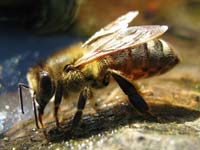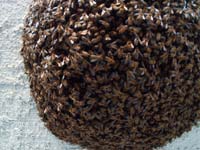
![]() Bee hives, with their regularly arranged honeycombs and permanently busy workers may seem like the picture of order. But look closer, and hives are often abuzz with secret codes, eavesdropping spies and deadly alliances.
Bee hives, with their regularly arranged honeycombs and permanently busy workers may seem like the picture of order. But look closer, and hives are often abuzz with secret codes, eavesdropping spies and deadly alliances.
 African honeybees are victimised by the parasitic small hive beetle. The beetles move through beehives eating combs, stealing honey and generally making a mess. But at worst, they are a minor pest, for the bees have a way of dealing with them.
African honeybees are victimised by the parasitic small hive beetle. The beetles move through beehives eating combs, stealing honey and generally making a mess. But at worst, they are a minor pest, for the bees have a way of dealing with them.
They imprison the intruders in the bowels of the hive and carefully remove any eggs they find. In turn, the beetle sometimes fools the bees by acting like one of their own grubs, and gets a free meal instead of imprisonment. In Africa, both species have found themselves in an evolutionary stalemate.
But in 1998, American beekeepers spotted the beetle in hives of their local European-descended honeybees. These insects are gentler versions of their aggressive African relatives, and in them, the beetles found more vulnerable victims.
In the last decade, they have spread through hives on the East Coast, causing much more destruction than they normally get away with. In some cases, the damage is so severe that the bees are forced to abandon their hive. As the bees suffer, so do the economically vital crops they pollinate.
Now, scientists from the International Centre of Insect Physiology and Ecology and the University of Florida have uncovered the secrets behind the beetle's destructive ability.
Small hive beetles hunt down beehives by hijacking their communications. When bees are stressed or confronted by threats, they release alarm pheromones into the air to alert their hive-mates of impending danger. But the beetles can also detect these chemical signals and use the bees' own early warning system to locate their hives.
Baldwyn Tonto and colleagues found that the beetles are sensitive to much lower levels of these pheromones than the bees themselves are, and can detect a much wider ranger of airborne chemicals from the hive. With their superior senses, the beetles can home in on beehives before the bees themselves can sense the alarm.
But that's not the whole story. Tonto found that honeycombs infested by beetles, but free of worker bees, were emitting a strange smell. It mimicked the bees' alarm pheromones and strongly attracted even more beetles. But it wasn't coming from the parasites themselves.
Instead, the source of the smell was a type of yeast that hitches a ride with small hive beetles into the bees' home. Tonto found that the fungus was fermenting the pollen collected by the bees, and releasing chemicals that closely mimic the beetle-attracting alarm pheromones.
 The beetles' keen sensitivity to the bees' chemical messages allows them to initially home in on a hive. As they arrive, they bring the yeast along for the ride and distribute it among the hive's pollen stores. The yeast ferments the pollen and releases chemicals that mimics the bee's alarm pheromone, attracting even more beetles .
The beetles' keen sensitivity to the bees' chemical messages allows them to initially home in on a hive. As they arrive, they bring the yeast along for the ride and distribute it among the hive's pollen stores. The yeast ferments the pollen and releases chemicals that mimics the bee's alarm pheromone, attracting even more beetles .
Soon, the infection reaches critical mass, and the bees are forced to abandon their homes. They leave behind a sizeable store of pollen and honey, ideal breeding grounds for the unwitting partnership of yeast and beetle.
But the yeast also exists in Africa, where it is similarly spread to hives by hive beetles. Why does the alliance not wreak such havoc there? Tonto believes that domestication is the answer. Because of years of selective breeding, the European honeybee is a slightly dopier version of the African bee - more docile and less prone to swarming.
It faces a larger number of pests and problems that prevent it from concentrating on imprisoning invading beetles. And its poor sensitivity to its own alarm chemicals allows the beetle-yeast alliance to gain a strong foothold before the bees recognise the threat.
With bee populations mysteriously dying off across America, the threat of the small hive beetle and its fungal partner may be even more pressing than before.
Reference: Torto, Boucias, Arbogast, Tumlinson & Teal. 2007. Multitrophic interaction facilitates parasite-host relationship between an invasive beetle and the honey bee. PNAS 104: 8374-8378.


Amazing attack methodology! Collect the labour of the bees without expending much energy yourself. "Unwitting" in the "conscious" sense but certainly this is an awesome evolved symbiotic relationship, anything but unwitting, between the yeast and the beetles, no?
The author name, Torto, is mispelled as "Tonto" ...